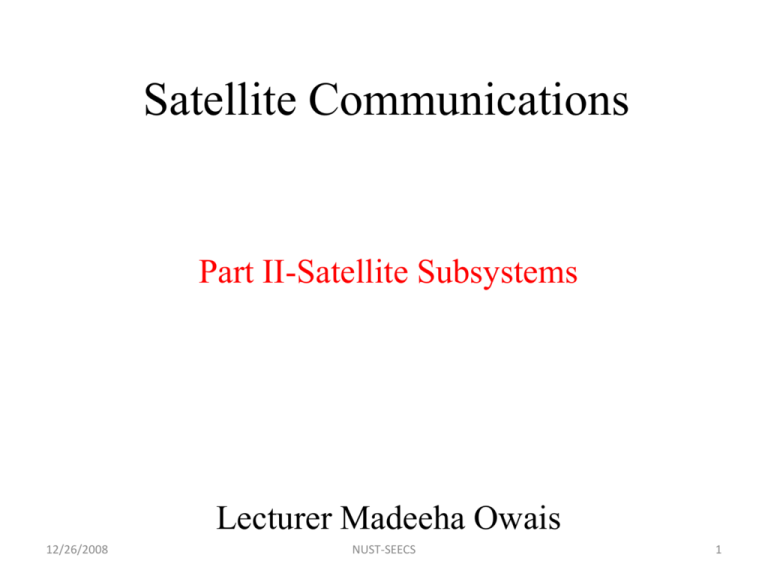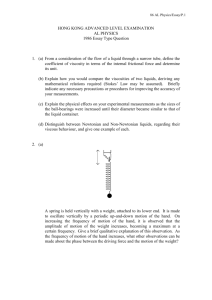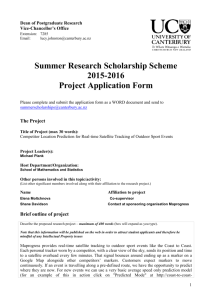
Satellite Communications
Part II-Satellite Subsystems
Lecturer Madeeha Owais
12/26/2008
NUST-SEECS
1
Learning Objectives
•
•
•
•
12/26/2008
Satellite Spacing in Orbit
Communication Satellite Classifications
Satellite System Link Model
Communication Satellite Subsystems
NUST-SEECS
2
Satellite Spacing in Orbit
– Geo-stationary satellites must share a limited space and
frequency spectrum within a given arc of geostationary orbit
– Each satellite is assigned a longitude in the geostationary arc
above the equator
– The position in the slot depends on the frequency band used.
– Satellites operating at or near the same frequency must be
sufficiently separated in space to avoid mutual interference
12/26/2008
NUST-SEECS
3
Satellite Spacing in Orbit
– Required spatial separation is dependent on the few
variables:
• Beam widths and side lobe radiation of both earth station
and satellite antennas
• RF carrier frequency
• Encoding or modulation technique used
• Acceptable limits of interference
• Transmit carrier power
– Initially,3˚ to 6 ˚ of spatial separation for geo-sats
– Now has been reduced to 2˚ to make available extra slots.
– Some positions in GEO orbit, such as mid-atlantic and midpacific position, have higher demand than others
12/26/2008
NUST-SEECS
4
Satellite Spacing in Orbit
12/26/2008
NUST-SEECS
5
Communication Satellite Classifications
Spinner Satellites
– Less common type
– Mostly used in relatively high-altitude
geosynchronous or Molniya orbits
– Intelsat VI Satellite, DSP (Defense
Support Program) Satellite of USA
DSP Satellite
Intelsat VI Satellite
Courtesy of Boeing Satellite Systems. All rights reserved.
Communication Satellite Classifications
Three-Axis Stabilized Satellites
– Their body is roughly box-shaped and
have deployable solar-array panels
– These keep their bodies stable through
inertia except for a slow motion about
one axis to keep their payload
antennas and sensors continuously
pointing towards Earth. The solar
panels are counter-rotated to track the
sun.
– Examples: Defense Meteorological
Satellite Program (DMSP), Japanese
Earth Resources Satellite (JERS),
Russian Communication Satellite,
Courtesy of Orbital Sciences Corp. All rights reserved.
Satellite System Link Model
Basic Sections:
•Uplink
•Transponder
•Downlink
Solar
panels
CSE 426-F2007
NDG Notes
8
Uplink Model
– Primary component
• Earth Station Transmitter
–
–
–
–
12/26/2008
IF modulator
IF-to-RF microwave up-converter
High Power Amplifier(Klystrons or Travelling-wave tubes )
Band pass filter
NUST-SEECS
9
Transponder
•Transponder (Transmitter + Responder) Model
• To be discussed in coming slides…..
12/26/2008
NUST-SEECS
10
Downlink Model
– Primary component
• Earth Station Receivers
– Input BPF
– LNA(tunnel diode)
– RF-to-IF down-converter(mixer+BPF)
12/26/2008
NUST-SEECS
11
Communication Satellite Subsystems
References:Satellites Communications by
Timothy Pratt Chapter 3,Titled:Satellites
12/26/2008
NUST-SEECS
12
• The major subsystems required on the communication satellite are:
– Attitude and orbit control system(AOCS):It consists of rocket motors
that are used to move the satellite back to the correct orbit when
external forces causes it to drift.
– Telemetry,Tracking,Command and Monitoring(TTC & M):This is
partly on the satellite and partly on the controlling earth station.
A dedicated earth station is used for this purpose.
Used for launch sequence deployment, monitoring of command
actions, report spacecraft health, control of thrusters and payload etc
– Power Systems: Mainly solar cells
– Communications Subsystem: These are major components
(represent small part of volume, weight and cost of sat in orbit) of a
communication satellite.Includes transponders and antennas
– Satellite Antennas: Type depends on functionality and coverage
12/26/2008
NUST-SEECS
13
Attitude and Orbital Control
•
•
•
•
AOC system keeps the satellite pointed towards the desired location on the earth.
Attitude control means controlling the angular orientation
AOCS is needed to get the satellite into the correct orbit and keep it there.
Several factors make the space craft tend to rotate and wobble(nutation) and change
orbit(e.g gravitational forces from sun,moon ,solar pressure,variations in earth’s
magnetic field) for which orbit maintenance is required
• Different forms of stabilization for fine pointing are used depending upon type of
the satellite
http://en.wikipedia.org/wiki/Nutation
12/26/2008
NUST-SEECS
14
– Few Basic Definitions
• Roll, Pitch, and Yaw
CSE 426-F2007
NDG Notes
15
Stabilization of Spinner
– Spinner Satellites use the angular
momentum of its spinning body to provide
stabilization
– Entire craft is rotated at 30-100RPM to
provide gyroscopic force
– Keeps satellite point in same direction
http://www.gyroscopes.org/behaviour.asp
http://en.wikipedia.org/wiki/Gyroscope
DSP Satellite
Stabilization of Three-Axis Stabilized Sat
– Three-Axis Stabilized Satellites
keep their body fixed relative to
Earth’s surface and an internal
subsystem provides roll and yaw
stabilization
– “momentum wheel”, which is a
solid metallic disk driven by an
electric motor is used . By
spinning the disk, the stability of
the satellite is maintained.
Telemetry and Monitoring (T&M)
in TTC & M
• Collects data from many sensors and send them to the control
earth station for reporting of spacecraft health
–
–
–
–
–
–
Pressure in fuel tanks
Current drawn by each subsystem
Critical voltages and currents
Temperature
Status and position of switches
Devices used to maintain attitude
• Low date rate is used to allow the receiver at the earth station
to have narrow band-width and maintain high C/N ratio
12/26/2008
NUST-SEECS
18
Tracking(T) in TTC & M
• The determination of the current orbit and position of the
spacecraft
• Velocity and Acceleration sensors are employed
• The control earth station can observe the doppler shift of the
telemetry carrier to determine the rate of change of range.
• Triangulation can be used from measurements from several
earth stations observing the satellite
12/26/2008
NUST-SEECS
19
Command(C) in TTC & M
• Secure and effective command structure is vital for the
successful launch and operation of a communication satellite.
• During launch sequence backup command system is used to:
– Switch on full power so that handover to the main TTC & M is possible
– Deploy antennas and solar panels
– Point antennas to desired location
• In orbit it is used for:
– Making changes in attitude and orbit correction
– Maintain spacecraft thermal balance
– Controlling the communication system
12/26/2008
NUST-SEECS
20
Command(C) in TTC & M
• Safeguards against errors in the received commands are built
in command structure
– Command originates at the control terminal by converting a control
code into a command word which is sent in a TDM frame.
– Validity is checked and sent back via the telemetry link where it is
checked again on computer
– If the command word is received correctly, an execute instruction will
be sent to satellite
– The entire process takes 5-10sec.And minimizes the risk of
malfunctioning
12/26/2008
NUST-SEECS
21
Typical Tracking,
Telemetry and
Command System
12/26/2008
NUST-SEECS
22
Power System
• All communication satellites obtain their power from solar cell
• Solar radiation falling on a geostationary spacecraft has
intensity of 1.39 kw/m2
• Efficiency of solar cells falls with time due to aging and
etching of surface.
• Spacecrafts carry batteries to power the subsystems during
launch and eclipses
12/26/2008
NUST-SEECS
23
Communications Subsystem-1
• A communication satellite exists to provide a platform in orbit
for relaying voice, video and data communications
• All other subsystems on the satellite exist to support the comm
system
• Only source of revenue
• Design is to maximize the traffic capacity
• Downlink design is the critical part due to limited transmitter
power and antenna size and gain.
• Received power level rarely exceeds 10-10W
• Satisfactory performance->S/N in receiver must be between
5dB and 25dB depending on the bandwidth of transmitted
signal and modulation used.
12/26/2008
NUST-SEECS
24
Communications Subsystem-2
• Early Communication Satellite(Power Limited)
– Transponders B.W=250 or 500Mhz
– Transmitter output power=1 to 2 W
• Later generations(Bandwidth limited)
– Transmitter output power up to 200W
– Increased total channel capacity by re-use of frequency
• Techniques employed for Re-use
– Spatial Frequency Reuse->Multiple directional antenna beams at the
same frequency
– Polarization Reuse->Orthogonal polarization at same frequency
– Geo-sats have achieved effective B.W=2250 MHz within a 500MHz
band at 6/4 GHz by using spatial and polarization frequency reuse
12/26/2008
NUST-SEECS
25
Communications Subsystem-3
12/26/2008
NUST-SEECS
26
Communications Subsystem-4
Repeater/Transponder
• The total Repeater bandwidth(up to 500MHz-1.5GHz) is split into
sub-bands(a few tens of MHz).
•Each sub-band is then amplified by a Transponder.
12/26/2008
NUST-SEECS
27
Communications Subsystem-5
Transponder Frequency Plan
• Transponder arrangement of RCA’s SATCOM satellite
• 24 active transponders by adopting orthogonal polarization frequency re-use
• 500MHz B.W divided into channels of 36MHz
• Center frequencies are spaced 40MHz apart to allow guard bands
3800
12/26/2008
NUST-SEECS
28
Communications Subsystem-6
Transponder Technology
Processing
Transparent
• Two Types
•Transparent(Bentpipe) Transponders
•Onboard Processing(Regenerative)Transponder
12/26/2008
NUST-SEECS
29
Communications Subsystem-7
Transponder Technology
• Functionality of Transparent(Bentpipe) Transponder
•Frequency Translation
•Amplification
12/26/2008
NUST-SEECS
30
Communications Subsystem-8
•
Correct
mistake in
book
12/26/2008
NUST-SEECS
31
Communications Subsystem-9
Transponder Technology
• Functionality of Onboard Processing(OBP) Transponder
•Uplink is demodulated, data recovered prior to processing
•After processing, data is reformatted for transmission on
downlink
12/26/2008
NUST-SEECS
32
•
•
•
•
Satellite Antennas
Wire Antennas:monopoles and dipoles
Horn Antennas
Reflector Antennas
Array Antennas
12/26/2008
NUST-SEECS
33
Satellite Antenna Radiation Patterns: Footprints
• Footprint: Geographical representation of satellite antenna radiation
pattern. It is the area on Earth’s surface that the satellite can receive
from or transmit to.
• Shape of footprint depends on:
• Orbital Path,
• Height,
• Antenna used
Same EIRP Contour Lines Super-imposed on a Geo-graphical Map
12/26/2008
NUST-SEECS
34
http://personal.ee.surrey.ac.uk/Personal/L.Wood/publications/lloyd-wood-iwssc-08-tutorial.pdf
12/26/2008
NUST-SEECS
35
Footprint Categories
•
•
•
•
Spot
Zonal
Hemispherical
Earth(Global)
12/26/2008
NUST-SEECS
36
Footprint Categories
• Spot and Zonal Beams:
– Concentrated power to very small geographical areas
– Have high EIRPs
– Blanket less than 10% of earth’s surface
• Hemispherical Beam
– Blanket 20% of Earth’s surface
– Have EIRP that are 3dB lower than spot beams
• Earth(Global)
–
–
–
–
Beamwidth of approximately 17˚
Coverage of upto 42% of earth’s surface
Power levels are considerably low
Require large receive dishes for adequate signal detection
12/26/2008
NUST-SEECS
37
12/26/2008
NUST-SEECS
38
Relations to Remember
• An aperture antenna has a gain G given by
– G = ηA4πA/λ2
where A=area of the antenna aperture in meters
λ=wavelength in meters
ηA=aperture efficiency
• If aperture is circular,G= ηA(πD/λ)2
where D=diameter of circular aperture in meters
• 3 dB Beam width and aperture dimension are related by:
θ3dB=75 λ/D degrees
• For antennas with ηA=60% :
G=33,000/(θ3dB )2
where G is not in decibels and beam width is in degrees.Value of constant varies
from 28,000 to 35000 for different sources.33,000 typical for reflectors
39
Coverage of
Geostationary Satellite
http://personal.ee.surrey.ac.uk/Personal/L.Wood/publications/lloyd-wood-iwssc-08-tutorial.pdf
12/26/2008
NUST-SEECS
40
Coverage of
Geosynchronous Satellite
http://personal.ee.surrey.ac.uk/Personal/L.Wood/publications/lloyd-wood-iwssc-08-tutorial.pdf
12/26/2008
NUST-SEECS
41
Coverage of
Molniya
http://personal.ee.surrey.ac.uk/Personal/L.Wood/constellations
12/26/2008
NUST-SEECS
42
Footprint of Iridium
http://personal.ee.surrey.ac.uk/Personal/L.Wood/constellations/
12/26/2008
NUST-SEECS
43
Footprint of Teledesic with 840 and 288 satellites
12/26/2008
NUST-SEECS
44
http://personal.ee.surrey.ac.uk/Personal/L.Wood/constellations/
Reading Assignment
Chapter 3-Timothy Pratt Book
pg 57-92,exclude maths on pg 90
Recommended site visit for Everyone!
http://personal.ee.surrey.ac.uk/Personal/L.Wood/constellations/
12/26/2008
NUST-SEECS
45








